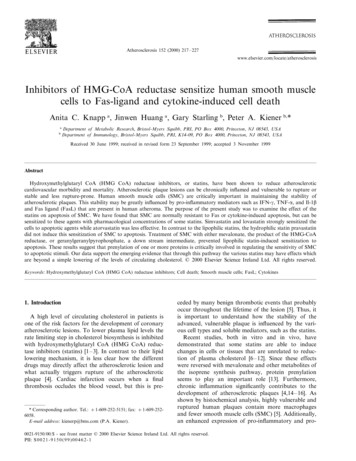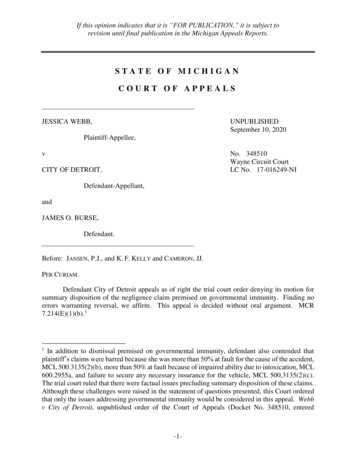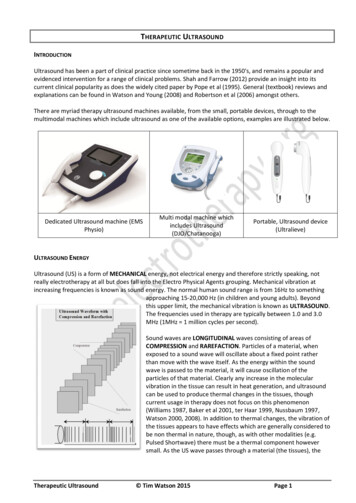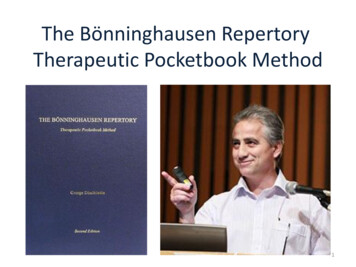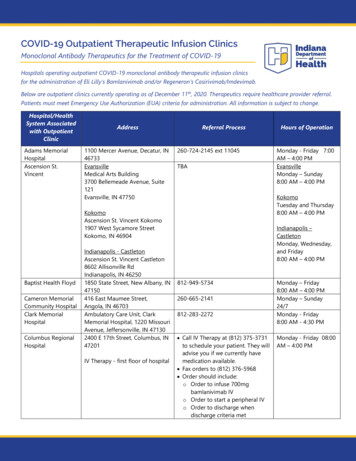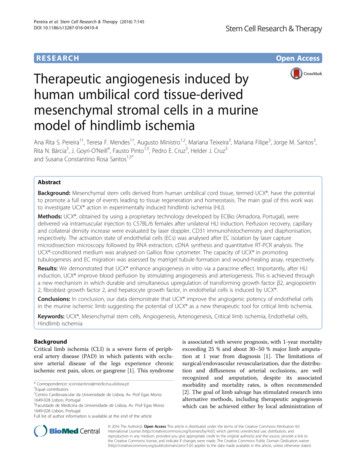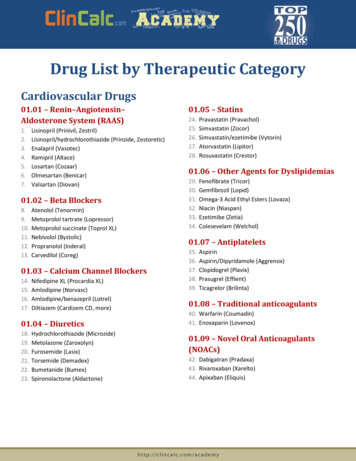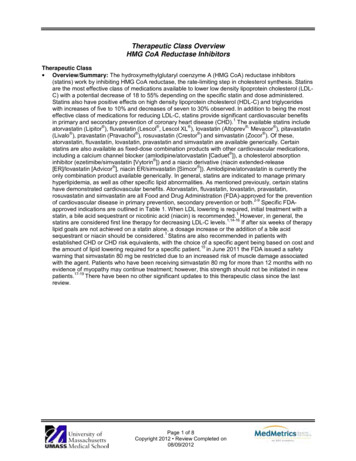
Transcription
Therapeutic Class OverviewHMG CoA Reductase InhibitorsTherapeutic Class Overview/Summary: The hydroxymethylglutaryl coenzyme A (HMG CoA) reductase inhibitors(statins) work by inhibiting HMG CoA reductase, the rate-limiting step in cholesterol synthesis. Statinsare the most effective class of medications available to lower low density lipoprotein cholesterol (LDLC) with a potential decrease of 18 to 55% depending on the specific statin and dose administered.Statins also have positive effects on high density lipoprotein cholesterol (HDL-C) and triglycerideswith increases of five to 10% and decreases of seven to 30% observed. In addition to being the mosteffective class of medications for reducing LDL-C, statins provide significant cardiovascular benefits1in primary and secondary prevention of coronary heart disease (CHD). The available statins include , atorvastatin (Lipitor ), fluvastatin (Lescol , Lescol XL ), lovastatin (Altoprev Mevacor ), pitavastatin (Livalo ), pravastatin (Pravachol ), rosuvastatin (Crestor ) and simvastatin (Zocor ). Of these,atorvastatin, fluvastatin, lovastatin, pravastatin and simvastatin are available generically. Certainstatins are also available as fixed-dose combination products with other cardiovascular medications, including a calcium channel blocker (amlodipine/atorvastatin [Caduet ]), a cholesterol absorption inhibitor (ezetimibe/simvastatin [Vytorin ]) and a niacin derivative (niacin extended-release [ER]/lovastatin [Advicor ], niacin ER/simvastatin [Simcor ]). Amlodipine/atorvastatin is currently theonly combination product available generically. In general, statins are indicated to manage primaryhyperlipidemia, as well as other specific lipid abnormalities. As mentioned previously, certain statinshave demonstrated cardiovascular benefits. Atorvastatin, fluvastatin, lovastatin, pravastatin,rosuvastatin and simvastatin are all Food and Drug Administration (FDA)-approved for the prevention2-9of cardiovascular disease in primary prevention, secondary prevention or both. Specific FDAapproved indications are outlined in Table 1. When LDL lowering is required, initial treatment with a1statin, a bile acid sequestrant or nicotinic acid (niacin) is recommended. However, in general, the1,14-16If after six weeks of therapystatins are considered first line therapy for decreasing LDL-C levels.lipid goals are not achieved on a statin alone, a dosage increase or the addition of a bile acid1sequestrant or niacin should be considered. Statins are also recommended in patients withestablished CHD or CHD risk equivalents, with the choice of a specific agent being based on cost and15the amount of lipid lowering required for a specific patient. in June 2011 the FDA issued a safetywarning that simvastatin 80 mg be restricted due to an increased risk of muscle damage associatedwith the agent. Patients who have been receiving simvastatin 80 mg for more than 12 months with noevidence of myopathy may continue treatment; however, this strength should not be initiated in new17-19There have been no other significant updates to this therapeutic class since the lastpatients.review.Page 1 of 8Copyright 2012 Review Completed on08/09/2012
Therapeutic Class Overview: HMG CoA reductase inhibitors2-13Table 1. Current Medications Available in Therapeutic ClassGenericFood and Drug Administration Approved Indications(Trade Name)Single Entity AgentsAtorvastatinHyperlipidemia: adjunct to diet to reduce TC, LDL-C and apo B levels in children with #(Lipitor )heterozygous FH*, adjunct to diet to reduce elevated TC, LDL-C, apo B and TG levels and toincrease HDL-C in patients with primary hypercholesterolemia and mixed dyslipidemia, adjunctto diet for the treatment of patients with elevated serum TG levels, reduce TC and LDL-C inpatients with homozygous FH as an adjunct to other lipid lowering treatments or if such†treatments are unavailable, treatment of patients with primary dysbetalipoproteinemiaPrimary prevention: in patients without clinically evident CHD to reduce the risk of angina, MI,‡revascularization procedures and stroke , in patients with type 2 diabetes, and without clinicallyevident CHD, but with multiple risk factors for CHD, to reduce the risk of MI and strokeSecondary prevention: in patients with clinically evident CHD to reduce the risk of angina,§ hospitalization, MI , revascularization procedures and strokeFluvastatinHyperlipidemia: adjunct to diet to reduce TC, LDL-C and apo B levels in children with *¶(Lescol , Lescolheterozygous FH , adjunct to diet to reduce elevated TC, LDL-C, apo B and TG levels and to increase HDL-C in patients with primary hypercholesterolemia and mixed dyslipidemiaXL )Secondary prevention: in patients with clinically evident CHD to reduce the risk ofrevascularization procedures and to slow the progression of coronary atherosclerosisLovastatin (Altoprev , #Mevacor )Hyperlipidemia: adjunct to diet to reduce TC, LDL-C and apo B levels in children withheterozygous FH (IR only)**, adjunct to diet to reduce elevated TC, LDL-C, apo B and TGlevels and to increase HDL-C in patients with primary hypercholesterolemia and mixed††dyslipidemia‡‡Primary prevention: in patients without clinically evident CHD to reduce the risk of angina , MI§§and revascularization proceduresSecondary prevention: in patients with clinically evident CHD to slow the progression of coronary atherosclerosisPitavastatin (Livalo )Hyperlipidemia: adjunct to diet to reduce elevated TC, LDL-C, apo B and TG levels and toincrease HDL-C in patients with primary hypercholesterolemia and mixed dyslipidemiaPravastatin #(Pravachol )Hyperlipidemia: adjunct to diet to reduce TC, LDL-C and apo B levels in children with¶¶heterozygous FH , adjunct to diet to reduce elevated TC, LDL-C, apo B and TG levels and toincrease HDL-C in patients with primary hypercholesterolemia and mixed dyslipidemia, adjunctPage 2 of 8Copyright 2012 Review Completed on 08/09/2012Dosage Form/StrengthGenericAvailabilityTablet:10 mg20 mg40 mg80 mga Capsule (Lescol ):20 mg40 mgExtended-release tablet (Lescol XL ):80 mgExtended-release tablet (Altoprev ):20 mg40 mg60 mgaa Tablet (Mevacor ):10 mg20 mg40 mgTablet:10 mg20 mg40 mg80 mgTablet:1 mg2 mg-a
Therapeutic Class Overview: HMG CoA reductase inhibitorsGeneric(Trade Name)Food and Drug Administration Approved Indicationsto diet for the treatment of patients with elevated serum TG levels, treatment of patients with†primary dysbetalipoproteinemiaPrimary prevention: in patients without clinically evidence CHD to reduce the risk ofcardiovascular mortality with no increase in death from noncardiovascular causes, MI andrevascularization proceduresSecondary prevention: in patients with clinically evident CHD to reduce the risk of MI,##revascularization procedures, stroke and total mortality by reducing coronary death and toslow the progression of coronary atherosclerosisRosuvastatinHyperlipidemia: adjunct to diet to reduce TC, LDL-C and apo B levels in children with (Crestor )heterozygous FH***, adjunct to diet to reduce elevated TC, LDL-C, apo B and TG levels and toincrease HDL-C in patients with primary hypercholesterolemia and mixed dyslipidemia, adjunctto diet for the treatment of patients with elevated serum TG levels, reduce TC, LDL-C and apoB in patients with homozygous FH as an adjunct to other lipid lowering treatments or if such†††treatments are unavailable, treatment of patients with primary dysbetalipoproteinemiaPrimary prevention: in patients without clinically evident CHD to reduce the risk of MI,‡‡‡revascularization procedures and strokeSecondary prevention: in patients with clinically evident CHD to slow the progression of coronary atherosclerosisSimvastatinHyperlipidemia: adjunct to diet to reduce TC, LDL-C and apo B levels in children with #(Zocor )heterozygous FH***, adjunct to diet to reduce elevated TC, LDL-C, apo B and TG levels and toincrease HDL-C in patients with primary hypercholesterolemia and mixed dyslipidemia, adjunctto diet for the treatment of patients with elevated serum TG levels, reduce TC and LDL-C inpatients with homozygous FH as an adjunct to other lipid lowering treatments or if such§§§treatments are unavailable, treatment of patients with primary dysbetalipoproteinemiaSecondary prevention: in patients at high risk of coronary events because of existing CHD,diabetes, peripheral vessel disease, history of stroke or other cerebrovascular disease toreduce the risk of nonfatal MI, nonfatal stroke, revascularization procedures and total mortalityby reducing CHD deathCombination ProductsAmlodipine/Hyperlipidemia (atorvastatin): adjunct to diet to reduce TC, LDL-C and apo B levels in childrenatorvastatinwith heterozygous FH*, adjunct to diet to reduce elevated TC, LDL-C, apo B and TG levels and #(Caduet )to increase HDL-C in patients with primary hypercholesterolemia and mixed dyslipidemia,adjunct to diet for the treatment of patients with elevated serum TG levels, reduce TC and LDLC in patients with homozygous FH as an adjunct to other lipid lowering treatments or if such†treatments are unavailable, treatment of patients with primary dysbetalipoproteinemiaPrimary prevention (atorvastatin): in patients without clinically evident CHD to reduce the risk of‡angina, MI, revascularization procedures and stroke , in patients with type 2 diabetes, andPage 3 of 8Copyright 2012 Review Completed on 08/09/2012Dosage Form/StrengthGenericAvailability4 mgTablet:5 mg10 mg20 mg40 mgTablet:5 mg10 mg20 mg40 mg80 mgTablet:2.5/10 mg2.5/20 mg2.5/40 mg5/10 mg5/20 mg5/40 mg5/80 mg-aa
Therapeutic Class Overview: HMG CoA reductase inhibitorsGeneric(Trade Name)Ezetimibe/simvastatin (Vytorin )Niacin ER/lovastatin (Advicor )Niacin ER/simvastatin (Simcor )Food and Drug Administration Approved Indicationswithout clinically evident CHD, but with multiple risk factors for CHD, to reduce the risk of MIand strokeSecondary prevention (atorvastatin): in patients with clinically evident CHD to reduce the risk of§ angina, hospitalization, MI , revascularization procedures and strokeOther (amlodipine): angiographically documented coronary artery disease, chronic stableangina, hypertension and vasospastic anginaHyperlipidemia: adjunct to diet to reduce elevated TC, LDL-C, apo B and TG levels and toincrease HDL-C in patients with primary hypercholesterolemia and mixed dyslipidemia, reduceTC and LDL-C in patients with homozygous FH as an adjunct to other lipid lowering treatmentsor if such treatments are unavailableHyperlipidemia (lovastatin and niacin ER): adjunct to diet to reduce elevated TC and LDL-C inpatients with primary hypercholesterolemia when response to diet restricted in saturated fatand cholesterol and to other nonpharmacological measures alone has been inadequate†† (lovastatin and niacin ER ), adjunct to diet for the treatment of patients with elevated serum¶¶¶TG levels (niacin ER)‡‡Primary prevention: in patients without clinically evident CHD to reduce the risk of angina , MI§§and revascularization proceduresSecondary prevention (lovastatin and niacin ER): in patients with clinically evident CHD to slow the progression of coronary atherosclerosis (lovastatin) , in patients with a history of MI andhypercholesterolemia to reduce the risk of recurrent nonfatal MI (niacin ER)Hyperlipidemia (simvastatin and niacin ER): adjunct to diet to reduce elevated TC, LDL-C, apoB and TG levels and to increase HDL-C in patients with primary hypercholesterolemia and###mixed dyslipidemia , adjunct to diet for the treatment of patients with elevated serum TG###levelsDosage Form/StrengthGenericAvailability10/10 mg10/20 mg10/40 mg10/80 mgTablet:10/10 mg10/20 mg10/40 mg10/80 mgTablet:500/20 mg750/20 mg1,000/20 mg1,000/40 mgTablet:500/20 mg500/40 mg750/20 mg1,000/20 mg1,000/40 mgapo apolipoprotein, CHD coronary heart disease, ER extended-release, FH familial hypercholesterolemia, HDL-C high density lipoprotein cholesterol, IR immediate release, LDL-C low densitylipoprotein cholesterol, MI myocardial infarction, TC total cholesterol, TG triglyceride*In boys and postmenarchal girls, 10 to 17 years of age, if after an adequate trial of diet therapy the following findings are present: low density lipoprotein cholesterol (LDL-C) remains 190 or 160mg/dL and there is a positive family history of premature cardiovascular disease or two or more other cardiovascular disease risk factors are present.†Who do not respond adequately to diet.‡With multiple risk factors for coronary heart disease (CHD) such as age, smoking, hypertension, low high-density lipoprotein cholesterol (HDL-C) or a family history of early CHD.§Nonfatal myocardial infarction. Fatal and nonfatal.¶In adolescent boys and girls, who are at least one year post menarche, 10 to 16 years of age if the following findings are present: LDL-C remains 190 or 160 mg/dL and there is a positive familyhistory of premature cardiovascular disease or two or more other cardiovascular disease risk factors are present.#Generic available in at least one dosage form and/or strength.**In adolescent boys and girls, who are at least one year post menarche, 10 to 16 years of age, if after an adequate trial of diet therapy the following findings are present: LDL-C remains 190 or 160 mg/dL and there is a positive family history of premature cardiovascular disease or two or more other cardiovascular disease risk factors are present.Page 4 of 8Copyright 2012 Review Completed on 08/09/2012---
Therapeutic Class Overview: HMG CoA reductase inhibitors††When response to diet restricted in saturated fat and cholesterol and to other nonpharmacological measures alone has been inadequate (extended-release [ER] and immediate-release [IR]tablets), reduction in elevated total cholesterol (TC) and LDL-C only in patients with primary hypercholesterolemia (IR tablets).‡‡Unstable angina.§§With average to moderately elevated TC and LDL-C, and below average HDL-C. As part of a treatment strategy t
HMG CoA Reductase Inhibitors Therapeutic Class Overview/Summary: The hydroxymethylglutaryl coenzyme A (HMG CoA) reductase inhibitors (statins) work by inhibiting HMG CoA reductase, the rate-limiting step in cholesterol synthesis. Statins are the most effective class of medications available to lower low density lipoprotein cholesterol (LDL-
